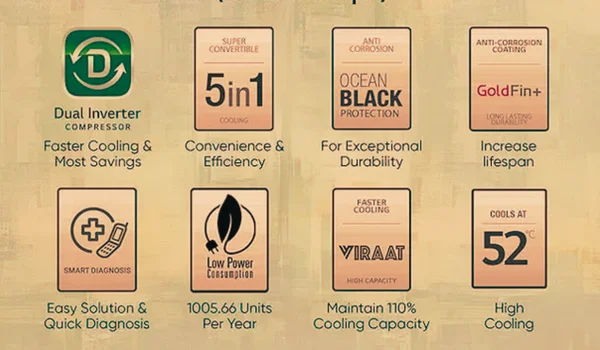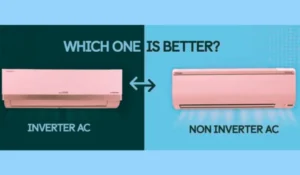As a tech enthusiast and electronics expert, I’ve spent considerable time analyzing and testing various air conditioners (ACs) to understand their specifications and performance. In this guide, I’ll break down the essential terms and specifications you should know before purchasing an AC, ensuring you make an informed decision tailored to your needs.
1. Tonnage (Cooling Capacity)
Tonnage refers to the cooling capacity of an AC, indicating how much heat it can remove from a room in an hour. In India, common sizes include 1 ton, 1.5 ton, and 2 ton units. The appropriate tonnage depends on room size, insulation, and heat load. For instance, a 1.5-ton AC is typically suitable for a room of 150-180 sq. ft. Choosing the right tonnage ensures efficient cooling and energy consumption.
2. BTU (British Thermal Unit)

BTU measures the amount of heat an AC can remove from a room per hour. Higher BTU ratings indicate greater cooling capacity. For example, a 12,000 BTU AC can cool a 400-450 sq. ft. room effectively. Matching the BTU rating to your room size ensures optimal performance and energy efficiency.
3. EER (Energy Efficiency Ratio)
EER is the ratio of an AC’s cooling capacity (in BTUs) to its power consumption (in watts). A higher EER indicates better energy efficiency. For instance, an AC with an EER of 10 is more efficient than one with an EER of 8. Considering EER helps in selecting an AC that offers better cooling with lower electricity bills.
4. ISEER (Indian Seasonal Energy Efficiency Ratio)
ISEER is a metric introduced by the Bureau of Energy Efficiency (BEE) in India to rate the energy efficiency of ACs based on seasonal variations. It considers the total amount of heat removed annually to the total energy consumed. Higher ISEER values signify better efficiency. For example, a 5-star rated AC typically has an ISEER of 4.5 or above. This rating helps consumers choose energy-efficient models suitable for Indian climates.
5. BEE Star Rating
The BEE star rating system ranges from 1 to 5 stars, indicating the energy efficiency of appliances, including ACs. A 5-star AC consumes less power compared to a 3-star model, leading to significant savings on electricity bills over time. It’s essential to check the validity period of the star rating, as standards are updated periodically.
6. Inverter vs. Non-Inverter ACs
Inverter ACs have variable-speed compressors that adjust their speed based on cooling requirements, leading to consistent temperatures and energy savings. Non-inverter ACs operate at fixed speeds, turning on and off to maintain temperatures, which can lead to higher energy consumption. In my experience, inverter ACs, though initially more expensive, offer better comfort and lower operating costs in the long run.
7. Refrigerant Type
Refrigerants are substances used in ACs for cooling. Common types include R-22, R-410A, and R-32. R-32 is more environmentally friendly, with a lower Global Warming Potential (GWP) compared to R-22 and R-410A. Opting for ACs with eco-friendly refrigerants contributes to environmental conservation and often aligns with newer, more efficient models.
8. Air Filters and Purification
Modern ACs come equipped with various air filters like HEPA, PM2.5, and anti-bacterial filters. These filters enhance indoor air quality by trapping dust, allergens, and microbes. If you have allergies or live in areas with high pollution levels, investing in an AC with advanced filtration systems can significantly improve your indoor environment.
9. Noise Levels
Noise levels, measured in decibels (dB), indicate how loud an AC operates. For bedrooms or study areas, selecting an AC with lower noise levels (around 20-30 dB) ensures a quiet and comfortable environment. Always check the noise specifications, especially for indoor units, to avoid disturbances.
10. Smart Features
Many ACs now offer smart features like Wi-Fi connectivity, app control, and voice assistant integration. These features allow remote operation, scheduling, and energy monitoring, enhancing convenience and efficiency. In my usage, smart ACs have provided greater control over cooling preferences and energy consumption.
Conclusion
Understanding AC specifications is crucial for selecting a unit that meets your cooling needs efficiently and economically. By paying attention to factors like tonnage, energy efficiency ratios, refrigerant types, and additional features, you can make an informed decision that ensures comfort and savings in the long term



